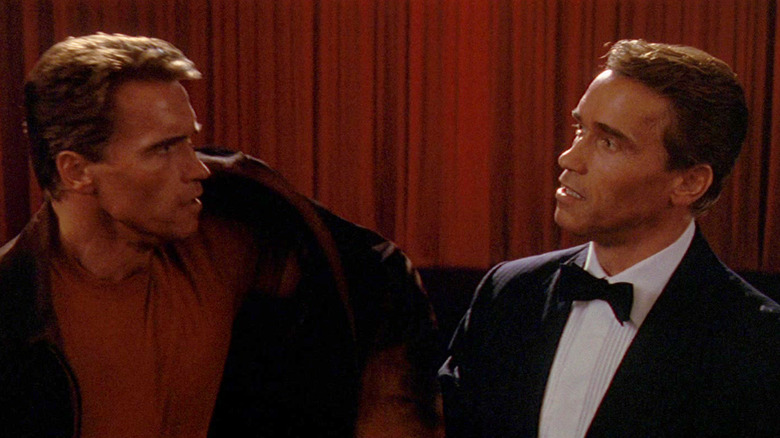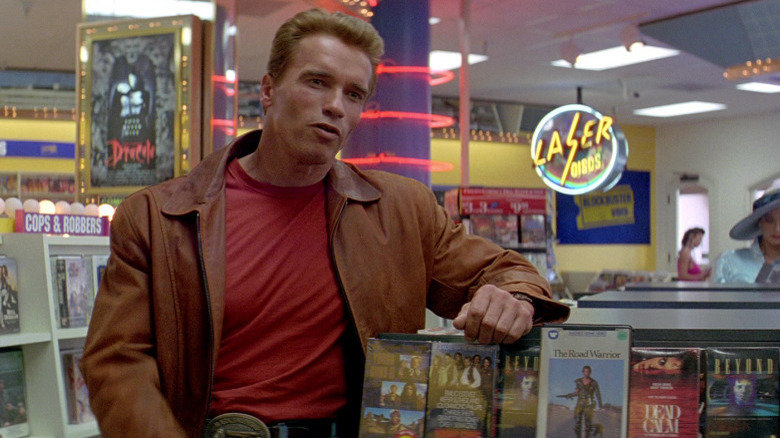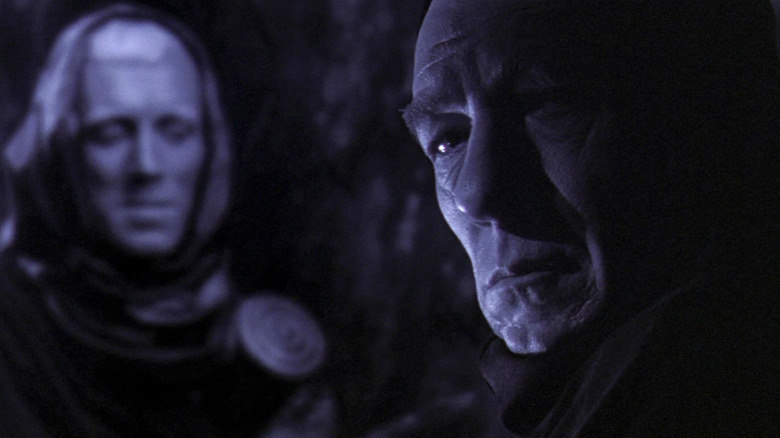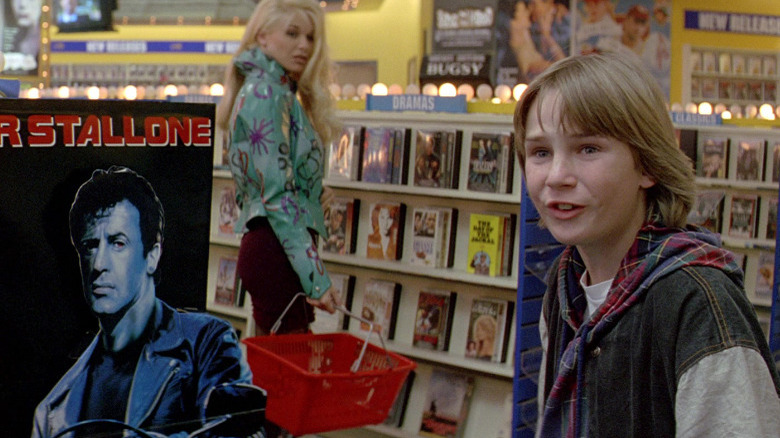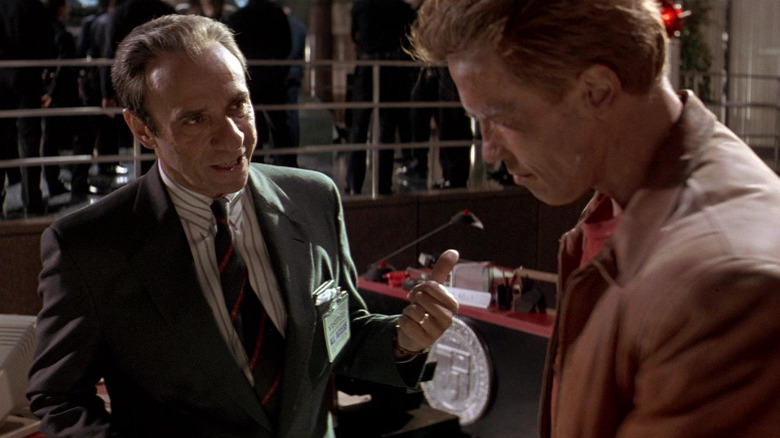Last Action Hero Deserves Credit For Creating A Blockbuster Multiverse Before The MCU
It's hard to imagine now, but there was a time when most people in the world probably didn't know — or care — what a "multiverse" is. And that time was just a few years ago, when the idea of an infinite number of alternate realities was mostly relegated to complex sci-fi stories and sprawling comic book continuities.
But that was then and this is now, and now is when the Marvel Cinematic Universe (MCU) has introduced the idea that not only are there multiple different versions of their heroes in multiple different universes, but also that every other movie featuring those characters — even the films that supposedly aren't "canon" — are just different parts of the multiverse. It's all connected, every part of it. Toss in the Spider-Verse too, because why not? It's all connected.
Heck, multiverses are so mainstream now that a complex independent film like "Everything Everywhere All At Once" can not only become a breakout hit, but also be a frontrunner for multiple Academy Awards, including Best Picture.
Yup, it sure is great that Marvel introduced mainstream audiences to the idea of the multiverse.
And it sure is annoying that "Last Action Hero" did it decades ago and it doesn't get any credit.
This isn't the movies anymore
The year was 1993 and the summer was full of potential blockbusters, but for better or worse, not every movie can be a smash hit. For every seemingly sure-fire success like "Jurassic Park" and "Cliffhanger," there were ambitious flops like "Super Mario Bros." and, surprisingly, "Last Action Hero."
"Last Action Hero" starred Arnold Schwarzenegger at the height of his celebrity and box office power, and was his first big follow-up to the pop culture sensation "Terminator 2: Judgment Day." The film was directed by John McTiernan, the director of massively successful films like "Die Hard," "The Hunt for Red October" and "Predator," and was co-written by Shane Black, who created the "Lethal Weapon" series. On paper, it seemed like a surefire success story.
In practice, the film's bizarre storyline about a young Arnold Schwarzenegger fanboy named Danny (Austin O'Brien) jumping into the fictional world of a fictional Schwarzenegger action franchise, making meta jokes about movie tropes, and then dragging Schwarzenegger's over-the-top film persona back into the real world, was a weird, tough sell. Especially since the film opened just one week after "Jurassic Park" changed the blockbuster movie landscape forever by offering CGI spectacles never before seen by the human eye.
The movie made what seems like a respectable $157 million at the box office, but to put that in context with the rest of 1993, that means it made less money than Jon Amiel's long-forgotten Jodie Foster/Richard Gere period romance "Sommersby," a remake of the French film "The Return of Martin Guerre." To say "Last Action Hero" performed under expectations would be very, very accurate.
The multiverse of movie madness
It's taken some time, but "Last Action Hero" finally went from being a Hollywood punchline to finding a respectful audience. It's an odd film that doesn't do nearly enough with its premise, but the ideas are big enough that it excites the mind.
The main premise of "Last Action Hero" is that every single movie is its own universe, and that universe continues whether or not we're watching it in our own world. The "Jack Slater" movies that Danny visits may be fictional, but we know for a fact that it applies to "real" movies too, since at the end of the film the living personification of Death from Ingmar Bergman's "The Seventh Seal" is also brought into the real world, as played by Sir Ian McKellen (yes, really).
This means that in the world of "Last Action Hero," every single movie is part of the multiverse, and when those movies are playing, every single screen is — at least potentially, with the aid of a magic ticket — a doorway to those other realms. It's not entirely unlike how in "Doctor Strange and the Multiverse of Madness" we learn that every dream in the MCU is a vision of an actual alternate reality. Although it's a lot less upsetting to learn that Paddington is real than it is to learn that yes, somewhere in the universe, you really did go to school in your underwear.
Where this gets complicated, however, is when movies acknowledge that other movies also exist, and when the roles for actors begin to overlap. That's where the "Last Action Hero" rules get complicated, and it's also where the Marvel Cinematic Universe — which by definition, must take place in the "Last Action Hero" multiverse — gets weirder than usual.
Who plays Mace Windu in the MCU?
One of the most memorable scenes in "Last Action Hero" takes place in a video store within Jack Slater's fictional universe, where Danny discovers that in this world, Arnold Schwarzenegger didn't star in "Terminator 2: Judgment Day." In this world Sylvester Stallone played the Terminator.
That means that if a movie stars a particular actor, then any other movies that actor appeared in will have been recast within that corner of the multiverse. So if Lydia Tár goes to see "The Lord of the Rings," she'll find that the character of Galadriel will have been played by someone other than Cate Blanchett.
This opens up a gigantic can of worms in the MCU, because the cast of the Marvel franchise is sprawling and the characters keep bringing up various real-life movies, so we know those films exist in their world. That means that when Tony Stark refers to Thor as "Lebowski" in "Avengers: Endgame," the "Big Lebowski" movie Tony Stark watched couldn't have starred Jeff Bridges, because Jeff Bridges played the villain in the first "Iron Man" movie.
It gets worse: Spider-Man brought up the "Star Wars" movies in "Captain America: Civil War," so that means that Harrison Ford — who has been cast in the next "Captain America" movie, didn't play Han Solo in the MCU. (Maybe it was Glyn Turman, who in real life lost the role of Han Solo because he was black, Carrie Fisher was white, and their romance might have caused "too much controversy." Sigh.)
While we're at it, Oscar Isaac (Moon Knight) didn't play Poe Dameron, Andy Serkis (Ulysses Klaw) didn't play Snoke, and Samuel L. Jackson (Nick Fury) didn't play Mace Windu. That "Star Wars" list just goes on and on.
He killed Moe Zart!
The snake really starts to eat its own tail when you realize that one of the villains of "Last Action Hero," a cop played by F. Murray Abraham, has to be recast within the MCU because F. Murray Abraham also plays the god Khonshu in "Moon Knight." So that means that the MCU is inside the "Last Action Hero" universe, but "Last Action Hero" is within the MCU, and it had to be recast because that version it's technically a different film, while also being a film with the MCU inside it, which might create a whole new multiverse, come to think of it.
Look, maybe this whole "multiverse" thing really has gotten out of hand. Pretty soon the "Last Action Hero" universe is going to collide with the "Tommy Westphall" universe, and the cascade effect will destroy us all, until John Hughes's "Shermer, Illinois" universe shows up at the last minute to save the day.
It's fun to speculate about how the "Last Action Hero" multiverse affects practically any motion picture where other movies exist. In the comedy film "The Family," for example, a gangster in witness protection played by Robert De Niro watches "Goodfellas" in a theater. Who played the Robert De Niro role in that version of "Goodfellas?" Al Pacino? Harvey Keitel?
The mind boggles. Unlike the MCU, the "Last Action Hero" universe is a constant riddle, one to be reminded of and puzzled over every time you watch a movie, because every time you do, you're part of that multiverse. It makes you wonder who out there is watching you, and whether in that universe you, the reader of this article, are also an actor.
Maybe the real Terminator is you!
